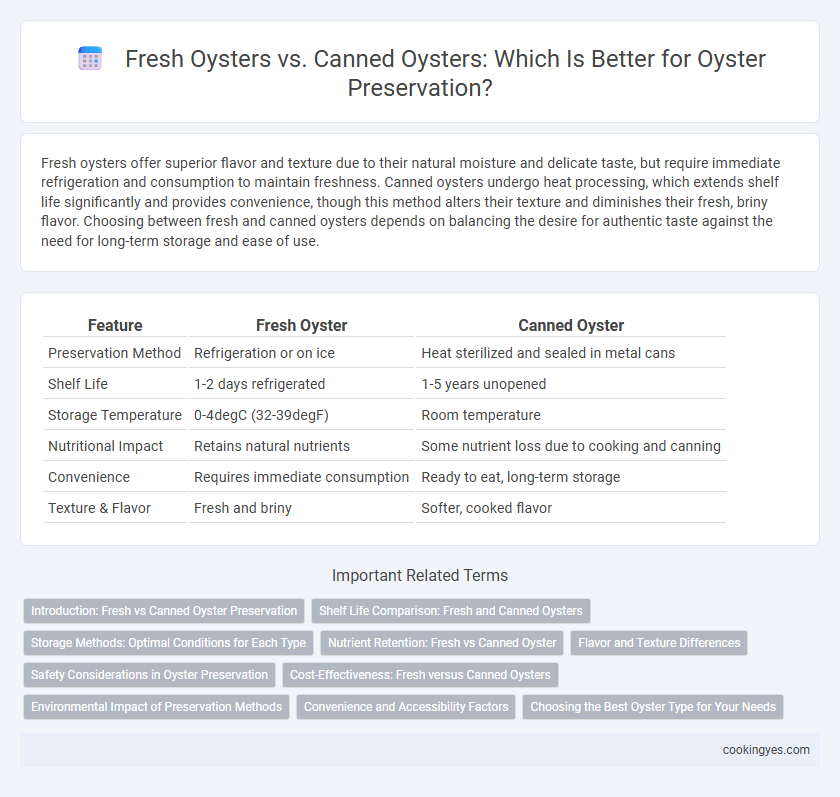Fresh oysters offer superior flavor and texture due to their natural moisture and delicate taste, but require immediate refrigeration and consumption to maintain freshness. Canned oysters undergo heat processing, which extends shelf life significantly and provides convenience, though this method alters their texture and diminishes their fresh, briny flavor. Choosing between fresh and canned oysters depends on balancing the desire for authentic taste against the need for long-term storage and ease of use.
Table of Comparison
| Feature | Fresh Oyster | Canned Oyster |
|---|---|---|
| Preservation Method | Refrigeration or on ice | Heat sterilized and sealed in metal cans |
| Shelf Life | 1-2 days refrigerated | 1-5 years unopened |
| Storage Temperature | 0-4degC (32-39degF) | Room temperature |
| Nutritional Impact | Retains natural nutrients | Some nutrient loss due to cooking and canning |
| Convenience | Requires immediate consumption | Ready to eat, long-term storage |
| Texture & Flavor | Fresh and briny | Softer, cooked flavor |
Introduction: Fresh vs Canned Oyster Preservation
Fresh oysters require refrigeration at temperatures between 32degF and 40degF to maintain quality and prevent bacterial growth, often lasting up to 7 days if properly stored. Canned oysters undergo heat processing and sealing, allowing preservation for up to two years without refrigeration, making them a convenient option for long-term storage. The preservation method impacts texture, flavor, and nutrient retention, with fresh oysters offering a briny taste and softer texture, while canned oysters have a more concentrated flavor due to the canning process.
Shelf Life Comparison: Fresh and Canned Oysters
Fresh oysters typically have a shelf life of 7-10 days when kept properly refrigerated at temperatures between 32-40degF (0-4degC), whereas canned oysters can last up to 3-5 years due to their airtight packaging and sterilization process. The high heat treatment in canning destroys bacteria and enzymes, significantly extending shelf life compared to fresh oysters that remain highly perishable. Consumers seeking long-term storage and convenience often prefer canned oysters, while fresh oysters are prized for their texture and flavor but require prompt consumption.
Storage Methods: Optimal Conditions for Each Type
Fresh oysters require refrigeration at temperatures between 34degF and 40degF with high humidity, ideally stored on a bed of ice to maintain moisture and ensure maximum freshness for up to 7 days. Canned oysters benefit from their hermetically sealed containers, allowing room-temperature storage for up to 3 years, though once opened, they must be refrigerated and consumed within a few days. Proper storage methods directly impact the preservation of flavor, texture, and safety for both fresh and canned oyster varieties.
Nutrient Retention: Fresh vs Canned Oyster
Fresh oysters retain higher levels of essential nutrients such as vitamin B12, zinc, and omega-3 fatty acids compared to canned oysters, which often undergo heat processing that can degrade these sensitive compounds. The canning process extends shelf life but typically reduces the bioavailability of certain vitamins and antioxidants. Consumers seeking maximum nutrient retention generally prefer fresh oysters due to their superior preservation of nutritional quality.
Flavor and Texture Differences
Fresh oysters offer a briny, sweet flavor with a tender, slightly chewy texture that reflects their natural marine environment. Canned oysters undergo heat processing, which intensifies their taste, making it richer but less nuanced, while the texture becomes firmer and more uniform due to cooking and preservation methods. For culinary uses emphasizing delicate texture and clean flavor, fresh oysters are preferred, whereas canned oysters excel in recipes needing a robust, consistent oyster presence.
Safety Considerations in Oyster Preservation
Fresh oysters require proper refrigeration between 0-4degC and consumption within 7 days to minimize the risk of Vibrio bacteria and foodborne illnesses. Canned oysters undergo high-heat sterilization, which eliminates pathogens and extends shelf life to 1-2 years, providing a safer option for long-term storage. Proper handling and storage practices are critical in both forms to ensure oyster safety and prevent contamination.
Cost-Effectiveness: Fresh versus Canned Oysters
Fresh oysters demand refrigeration and have a limited shelf life, which increases storage costs and potential waste, reducing their cost-effectiveness for long-term use. Canned oysters provide extended shelf life without refrigeration, lowering overall storage expenses and making them a budget-friendly option for consumers and businesses alike. The initial price of fresh oysters tends to be higher, while canned oysters offer a consistent, affordable alternative with less financial risk associated with spoilage.
Environmental Impact of Preservation Methods
Fresh oysters require refrigeration and quick consumption, leading to higher energy use and carbon emissions during transport and storage compared to canned oysters. Canned oysters undergo heat sterilization, allowing long shelf life without refrigeration, reducing energy consumption and food waste. However, canning generates packaging waste and involves metal processing that impacts environmental sustainability.
Convenience and Accessibility Factors
Fresh oysters offer superior taste and texture but require immediate consumption or careful refrigeration, making them less convenient for long-term storage. Canned oysters provide extended shelf life and easy accessibility, requiring no refrigeration and allowing longer storage at room temperature. For consumers prioritizing convenience and accessibility, canned oysters present a practical alternative without the perishability concerns associated with fresh oysters.
Choosing the Best Oyster Type for Your Needs
Fresh oysters offer superior flavor and texture, making them ideal for culinary dishes where taste and quality are paramount, but they require immediate consumption or refrigeration within 24 hours for optimal freshness. Canned oysters provide convenience and a longer shelf life, preserved in brine or oil, which is suitable for cooking applications that benefit from a more shelf-stable ingredient. Selecting the best oyster type depends on priorities such as flavor intensity, storage capacity, and intended recipe, with fresh oysters preferred for raw or gourmet preparation and canned oysters favored for extended storage and ease of use.
Fresh Oyster vs Canned Oyster for preservation Infographic

 cookingyes.com
cookingyes.com